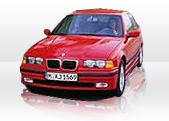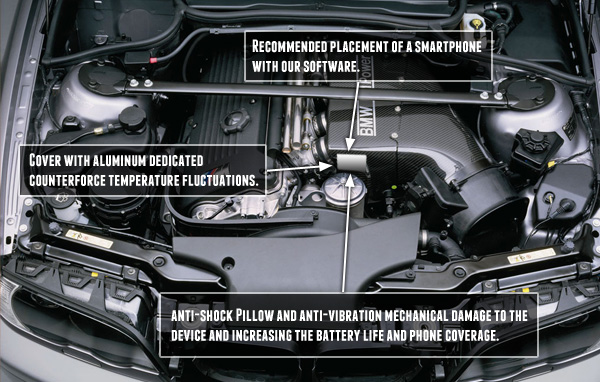
BMW 3 SERIES E36 GPS Tracking
Track your 3 SERIES E36 for free and visualize it on map
Produced to: 1999
How to track your favourite BMW - model 3 SERIES E36 in realtime for free ?
Producer remarks about this particular model
SERIES 3 E36 represent the third generation of middle class BMW. It was named „dolphin shape” and it was extremely popular in Europe. Wings as well as side markers are different in saloon than in coupe/convertible.Our product description
We are offering you completely free of charge our GPS car tracking solution in real time. The only thing you need to do is to install smartphone with Android inside your vehicle with our awesome application on board
If you want to track your BMW 3 SERIES E36 in real time you have to do the following :
1. Download Free Car Tracking Application for 3 SERIES E36 application from Google Play
2. Create free account on spysat.eu (for example johndoe) - here is detailed instruction
3. Define Device endpoint for each vehicle you want to track - give friendly name of your 3 SERIES E36 and PIN (some random will be provided - you can change it if you want)
4. Run SpySat mobile application on the smartphone and type there your LOGIN from SpySat (ex. johndoe) and PIN (from point 3.)
5. Install your smartphone inside the car
6. Enjoy watching position of your car at spysat.eu site.
7. Provide stable power supply - spysat app consumes some energy.
Best options to install smartphone inside BMW 3 SERIES E36

Our designers in collaboration with the BMW engineers have developed an optimal system namierzającego unit is placed in the engine. Based on the settings of the various parts of the engine, it was found that the optimal setting of the device software Car Track is have any of 30 cm from the battery.
Enclosure provides protection against mechanical shock and damage caused by temperature changes. A set of anti-vibration sponge thoroughly protect the device.
To permanently mount a smartphone inside your BMW 3 Series E36, follow these steps:1. First, make sure the phone is waterproof and has some extra battery life to power its external accessories.
2. Install an adapter plate that will attach to the underside of the car's floorboard. This will provide a secure mounting location for the smartphone. Look for a high-quality brand name product like Kenu or RAVVW.
3. Next, mount your phone in the designated spot using the appropriate mounts provided by the manufacturer. Some recommended options are the Kenu AirFrame or the RAVVW Sleeve Case with mounting brackets.
4. Connect the smartphone to the car's battery and set up a direct connection for seamless power supply. You can use an inline fuse or bypass the vehicle's electrical system completely to achieve this. However, be cautious not to drain your phone too quickly as it may cause damage over time.
5. Download our free GPS tracking app that is compatible with both Android and iOS devices. This app will allow you to monitor and control your smartphone remotely using a web-based interface or mobile app.
To ensure the longevity of your BMW 3 Series E36, we recommend scheduling regular maintenance appointments with a trusted mechanic. Additionally, be sure to follow proper driving habits such as maintaining proper speeds, avoiding harsh braking, and keeping tires properly inflated.
Users opinions and questions
Frequently Asked Questions:
What are the common problems associated with the VANOS system on E36 BMW 3 Series, and what are the recommended maintenance procedures to prevent these issues?
The VAnoS (Ventilated Air Noise Suppressor) system is a noise reduction device in the cooling system of some E36 BMW 3 Series cars. It helps to reduce engine compartment noise by venting hot air through vents at the base of the windshield. However, this system can experience several common issues:1. Leaks: One of the most common problems associated with VAnoS is leaks. This can cause coolant to leak into the cabin and create a messy situation. To prevent leaks, inspect the hoses and clamps regularly for signs of wear and tear, and replace them if necessary.
2. Clogged vents: The VAnoS system relies on venting hot air out of the engine compartment to function properly. If the vents become clogged with debris or corrosion, it can cause the system to malfunction. To prevent this, clean the vents regularly and remove any debris that accumulates in them.
3. Damaged fan: The VAnoS system also relies on a fan to vent hot air out of the engine compartment. If the fan becomes damaged or fails, it can cause the system to malfunction. To prevent this, inspect the fan regularly for signs of wear and tear, and replace it if necessary.
4. Malfunctioning thermostat: The VAnoS system relies on a thermostat to regulate coolant temperature. If the thermostat becomes damaged or fails, it can cause the system to malfunction. To prevent this, inspect the thermostat regularly for signs of wear and tear, and replace it if necessary.
To maintain the VAnoS system properly, it is recommended that you:
- Inspect the hoses and clamps regularly for signs of wear and tear, and replace them if necessary.
- Clean the vents regularly and remove any debris that accumulates in them.
- Inspect the fan regularly for signs of wear and tear, and replace it if necessary.
- Inspect the thermostat regularly for signs of wear and tear, and replace it if necessary.
What is the average lifespan of the timing chain and its recommended replacement interval in a BMW 3 Series E36 model?
The average life span of a timing chain in a BMW 3 Series E36 model can vary depending on the specific circumstances such as maintenance history, driving habits, and climate conditions. However, based on general industry standards, the recommended replacement interval for a timing chain is around 100,000 to 150,000 miles or approximately every 8-12 years. It's important to note that if the vehicle has experienced any significant engine performance issues, it may be wise to consider replacing the timing chain even if it hasn't yet reached the recommended mileage or age. Always consult your BMW dealership or a reputable mechanic for specific advice tailored to your individual situation.How does the advanced suspension system of the BMW 3 Series E36 ensure a smooth ride and responsive handling on both winding roads and highways?
The advanced suspension system of the BMW 3 Series E36 ensures a smooth ride and responsive handling on both winding roads and highways through its unique design and technology. Here's how it works:1. MacPherson Strut Front Suspension - The front suspension uses a MacPherson strut setup, which provides excellent stability and steering response. The strut is mounted inboard for optimal weight distribution and reduced unsprung weight. This results in better handling and a smoother ride on winding roads. Rear Multi-Link Suspension - The rear suspension uses a multi-link setup, which allows for greater control over wheel motion and improves stability at high speeds. This design also reduces body roll during cornering, making the car more responsive and nimble on winding roads. Dynamic Stability Control (DSC) - The E36 was one of the first BMW models to feature Dynamic Stability Control (DSC), an advanced traction control system that helps prevent skids and enhances stability during emergency maneuvers. This system also improves handling on both winding roads and highways by providing additional control and safety in challenging driving conditions. Adaptive Suspension - The E36 was also available with an optional adaptive suspension system, which continuously monitors road conditions and adjusts the damping to provide optimal handling and ride comfort. This technology ensures a smooth ride on highways while providing responsive handling on winding roads. Electronic Steering (EPS) - The E36 was one of the first BMW models to feature Electronic Power Steering (EPS), which provides precise steering response and reduces driver fatigue during long drives on highways. This technology also improves handling on winding roads by providing quick and responsive steering feedback. Overall, the advanced suspension system of the BMW 3 Series E36 ensures a smooth ride and responsive handling on both winding roads and highways through its combination of innovative designs, cutting-edge technologies, and intelligent engineering.
How can I diagnose and repair a persistent engine misfire on my BMW 3 Series E36?
Diagnosing and repairing an engine misfire on your BMW 3 Series E36 requires the following steps:1. Check for codes: Use an OBD II scanner to read any error codes stored in the car's computer. Look for P0300, P0301, or P0302 codes which indicate a cylinder misfire. This will help you narrow down the affected cylinder(s). Inspect the spark plugs: Remove and inspect each spark plug to determine if they are fouled, damaged, or worn out. Use a spark plug gap gauge to ensure that the gaps between electrodes are correct. Clean the spark plugs with a wire brush and replace them if necessary. Check the ignition coils: Verify that each ignition coil is functioning properly by using a multimeter to measure its resistance. A faulty coil may cause misfires in specific cylinders. Inspect the fuel injectors: Use a fuel pressure gauge and a vacuum gauge to test the fuel injectors for proper operation. A defective injector can lead to misfires or poor performance. Test the air intake system: Check the air filter, intake manifold gaskets, and throttle body for any signs of damage or blockages that could cause misfires. Inspect the fuel pump: Use a multimeter to test the voltage output from the fuel pump relay. A weak signal could indicate a faulty pump or wiring issue. Check the timing belt: Make sure that the timing belt is in good condition and properly tensioned. A damaged or loose belt can cause misfires due to incorrect valve timing. Inspect the crankshaft position sensor (CKP): Clean the CKP and test it for accuracy using a multimeter. A faulty sensor may trigger false misfire codes or affect engine performance. Test the camshaft position sensor (CMP): Verify that the CMP is functioning correctly by checking its output voltage with a multimeter. A failing sensor can cause misfires and poor fuel economy. Inspect the crankshaft and camshaft: Use a stethoscope to listen for any abnormal noises or vibrations in the engine. Worn bearings, damaged cam lobes, or bent crankshafts can cause misfires due to incorrect valve timing or poor ignition. Verify the fuel mixture: Check the air-fuel ratio using a wideband oxygen sensor and an OBD II scanner. A lean or rich mixture can cause misfires or other performance issues. Perform a compression test: Use a compression gauge to measure the cylinder pressure at each cylinder. Low compression could indicate worn piston rings, valves, or bearings that need replacement. Check the engine oil level and quality: Ensure that the oil is at the correct level and viscosity for your driving conditions. Insufficient lubrication can cause misfires due to increased wear and tear on critical engine components. By following these steps, you should be able to diagnose and repair any persistent engine misfire issues in your BMW 3 Series E36. Remember to always consult the manufacturer's service manual for specific instructions and safety precautions.